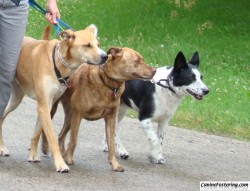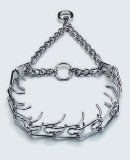Thoughts about the Prong Collar
Many many people have very strong feelings about the prong (or pinch) collar. I have to admit it does look like a piece of medieval torture equipment. It looks dangerous and almost violent. But it works like a dream on many many dogs.
Recently, in one of my classes I had a student who also happens to be a working veterinarian, who has a very rambunctious, very strong dog she recently adopted from rescue. She came to class with a head halti, the training device that covers the muzzle of the dog and helps to control the dog’s behavior by controlling their head, much like a bridle works for controlling a horse. While this tool is often very effective for some dogs it was not working for this dog. Her dog was lunging and jerking her all over the ring and the force of all that power was being absorbed by the dog’s neck. It was clear that she was becoming more frustrated and admitted after class that the halti wasn’t working. I suggested trying a prong but said she didn’t want to because she believed prong collars were “inhumane.” In my work as a trainer, I’ve learned that the best tool is the one that addresses the dog’s behavior problem with the least amount of force and that the owner feels comfortable and capable of working with. So, even though it was clear to me that the prong would likely work wonders, I spent time explaining ways she could make the head halti work for her and advised her to be more careful of how she worked with the halti.
The interesting thing is, I believe that she could have had success with my method of working with that tool. But it would have taken a LOT of work on her part to convey to the dog what behaviors were correct and which were not. It seems to me that a lot of dogs really just don’t understand that we’re frustrated with them when we yank them around by their leashes. It almost seems like they think it is a weird game we play. If you ever watch dogs play with each other you know how physical they are, how banging into and grabbing and jostling one another is all part of the fun. I really believe that most dogs being yanked around by their owners think that we’re having fun. To make the halti work for her in this case she had to make it crystal clear what behaviors were unwanted, and what ones were, and most importantly that this wasn’t a game but rather, work. This would take a lot of training sessions with impeccable timing and lots of attention. And frankly, most people want faster results or just don’t have the time to devote to this sort of thing.
 I don’t know what her specific situation is but this week in class she reached a sort of person limit. She was clearly frustrated and the dog was confused. When the handler and dog aren’t working as a team, no learning can happen. I gently suggested she just try out a prong for the class to see if she liked the results, and she agreed.
I don’t know what her specific situation is but this week in class she reached a sort of person limit. She was clearly frustrated and the dog was confused. When the handler and dog aren’t working as a team, no learning can happen. I gently suggested she just try out a prong for the class to see if she liked the results, and she agreed.
The results were, as you’d expect, remarkable. The behavior improved immediately and the handler became more calm, more confident and better able to train the dog. The dog’s focus on the handler improved and there was more eye contact between the two and therefore more opportunities to reinforce the focus and the work. I really watched this team and challenged myself to see if the dog had just “given up” or had lost its spark and was just complying out of fear. I didn’t see that. What I did see was the same dog, just a better, more focused, more self-controlled version. The dog seemed to finally understand the purpose of the whole training thing – it was like her mind said, “OH, that’s what you’re trying to tell me!” And when the handler expressed her pleasure at the dog’s behavior , the dog responded with pleasure right back. That’s the whole point of training in my opinion – to get on the same page with our dogs so we understand each other’s role and what is expected, and we know how to meet those expectations.
Moral to this story? Be careful of dismissing any training method or tool based on a story, a belief or an opinion. Keep your mind open and your focus on exploring what works. Trust your gut, but be honest with yourself. If your way of doing something isn’t working, ask for help and try something outside your comfort zone.





